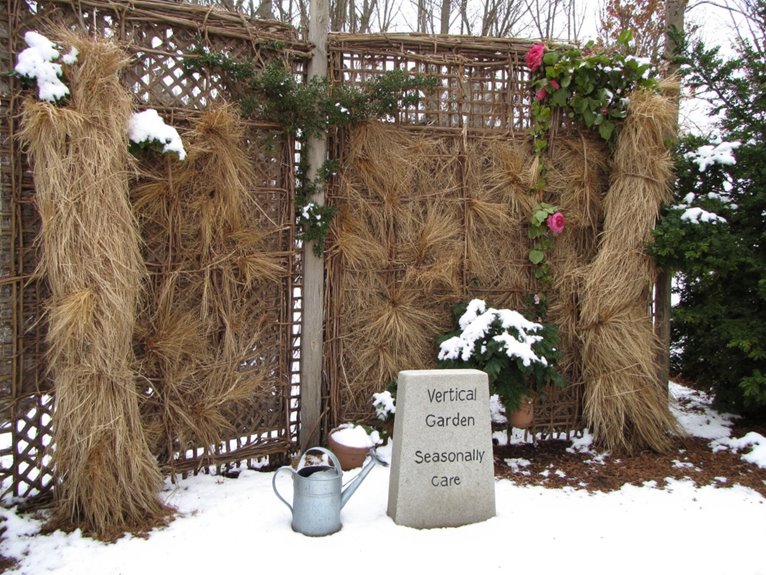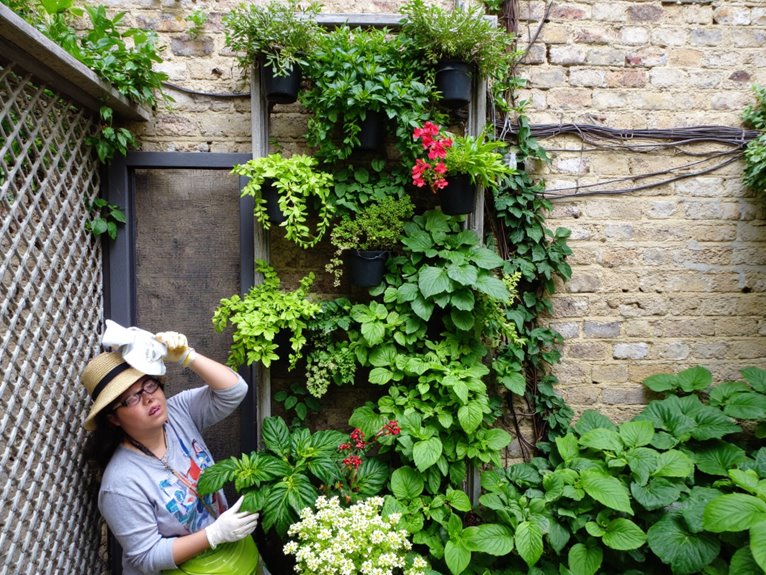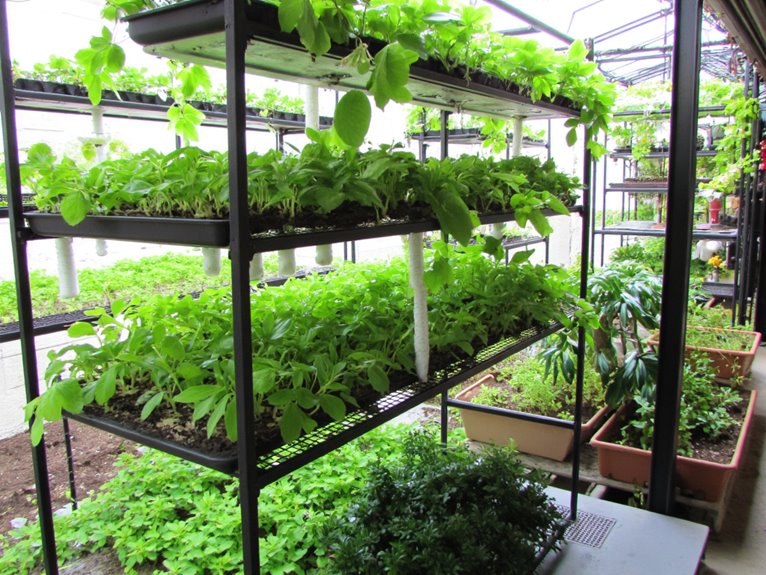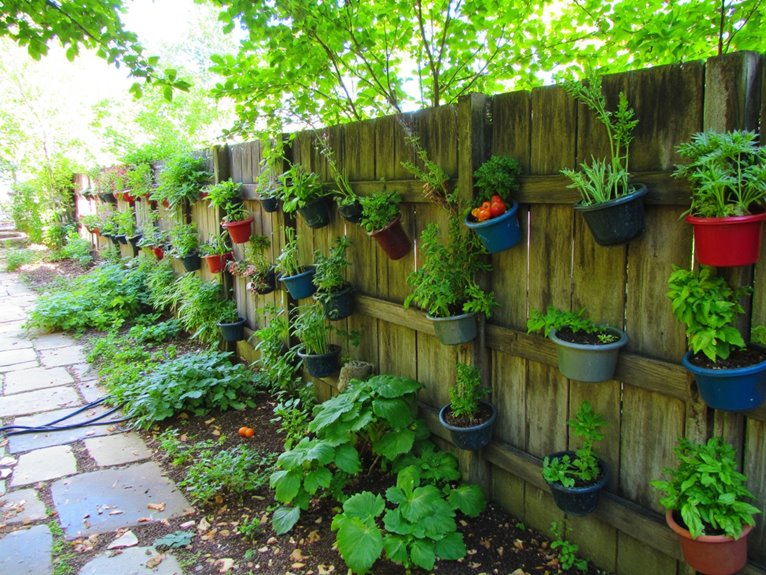Vertical Garden Maintenance Schedule: Caring for Multi-Level Plant Displays
You’ll need a structured vertical garden maintenance schedule combining daily watering checks, monthly pruning sessions, and annual soil refreshes for your multi-level plants. Drip irrigation systems deliver precise hydration while recirculation methods cut water use by up to 90%. Prune regularly to shape vines and remove yellow leaves, always making clean cuts to prevent disease spread. Check frameworks monthly for damage and clean filters to avoid clogs. As temperatures fluctuate, adjust watering practices and provide shade or frost protection as needed. With consistent care, your vertical garden will thrive—offering abundant harvests and beautiful displays year-round.
Notable Insights
- Inspect and clean vertical garden frameworks monthly to prevent structural issues.
- Water vertically gardens using drip irrigation or hydroponic systems for efficient hydration.
- Prune regularly to maintain plant shape, remove dead leaves, and control vine growth.
- Replace 33% of soil annually and fully when compacted to ensure nutrient availability.
- Monitor environmental conditions like temperature, humidity, and sunlight for optimal plant health.
Watering Techniques for Vertical Gardens
Whether you’re starting from scratch or expanding your green wall, setting up an efficient watering system is essential for keeping your vertical garden thriving. Drip irrigation delivers precise water directly to roots through emitters, optimizing water flow dynamics while minimizing waste. Hydroponic systems enhance nutrient delivery methods by adding balanced solutions to water, promoting faster growth in layered setups. Automated timers provide consistent hydration schedules tailored to plant needs with minimal effort. As water naturally drips down from upper layers, it nourishes lower plants too, creating a self-sustaining cycle. Regularly check for clogs and maintain clean filters to prevent blockages that disrupt flow patterns. For hard-to-reach areas in your vertical setup, battery-powered tools like pruning shears can help maintain clean cuts and proper plant health with minimal effort. With the right techniques, your vertical garden will flourish year-round, lush and full of life.
Water recirculation systems significantly improve efficiency by capturing and reusing excess moisture, reducing overall water consumption by up to 90% compared to traditional gardening methods.
Pruning and Trimming Practices
Modified Text with Alternative Words
As you work to keep your vertical garden looking its best, remember that pruning isn’t just about making plants look neat—it’s an essential practice that supports their health and growth. Regular trimming helps maintain shape, improve airflow, and direct energy to productive areas. For ideal branch angle optimization, always cut at a slant away from buds. Before you start, verify your pruning tool calibration is precise—sharp blades prevent tearing and disease spread.
When pruning, use removal cuts for dead branches, reduction cuts for shaping, or heading cuts to encourage bushier growth. For fast-growing vines, weekly light trimming keeps them contained. Always sterilize tools between plants to prevent pathogen spread. Remember to prune flowering vines after blooms and remove yellow leaves from climbing vegetables promptly.
Addition based on knowledge: “Always make clean cuts 1/4 inch above branches/buds to promote healing and direct growth.”
Seasonal Maintenance Adjustments
While vertical gardens offer year-round beauty, their care requires adapting practices to match seasonal shifts in weather and plant needs. As temperatures rise, adjust watering frequency and make sure Seasonal Shade Placement protects sensitive plants from sun damage. In colder months, use Frost protection materials like cloths or containers to shield vulnerable species. Check irrigation systems regularly for clogs, especially after winter debris buildup. Monitor pest activity closely in spring and summer when they’re most active. Adjust nutrient levels based on seasonal growth patterns while maintaining proper aeration in the growing medium. Consider using grow bags with breathable materials to ensure effective drainage and avoid waterlogged conditions during heavy rainfall periods.
Nutrient and Soil Management
Modified Text
Once you’ve established your vertical garden framework, nurturing the soil becomes essential to sustaining healthy growth across multiple levels. A balanced mix of potting mix, compost, and coco coir provides ideal nutrient content and drainage, while perlite improves aeration without sacrificing moisture retention.
Regular nutrient testing helps identify deficiencies or excesses, guiding precise fertilizer applications that support vigorous plant development. As soils degrade over time, consider soil replacement to maintain prime structure and fertility—especially in high-traffic vertical setups where leaching is common.
Monitor moisture levels closely, as vertical gardens often require more frequent watering due to increased exposure. When using coco coir as a growing medium, maintain pH levels between 5.5 to 6.5 and consider buffering coco coir with calcium and magnesium solutions to prevent common deficiencies. By prioritizing soil health through testing and timely amendments, you’ll create a stable foundation for thriving plants at every level of your garden.
Pest and Disease Control Methods
When you’re tending to a vertical garden, keeping an eye on pests and diseases is as important as nurturing the soil itself, since elevated plants often face unique challenges. Early detection through regular monitoring enables timely action using methods like hand-picking slugs or deploying yellow sticky traps.
| Method Type | Example Technique | Key Benefit |
|---|---|---|
| Physical/Mechanical | Row covers | Excludes pests physically |
| Biological/Natural | Ladybugs & predatory mites | Natural predator introduction |
| Cultural | Quarantine procedures for new plants | Prevents pest introductions |
Use neem oil or garlic sprays for organic control, and prioritize clean soil to avoid disease spread. By combining these approaches, you’ll create a resilient vertical ecosystem that thrives with minimal chemical intervention.
(124 words)
Harvesting and Plant Training
As your vertical garden matures, mastering harvesting techniques and plant training becomes essential for maximizing both yield and visual appeal. Harvest timing optimization guarantees you pick produce at peak ripeness, when fruits are most visible and accessible. Use shears for clean cuts on vining crops like cucumbers or tomatoes, and try batch harvesting herbs by cutting entire sections to encourage regrowth. Compare training methods – trellises work well for beans and peas, while cages support heavy fruiting plants like squash. Organize your display with sequential harvesting, working from top to bottom to maintain a neat appearance. Regular pruning will keep plants compact and improve airflow, reducing disease risk.
Setting Up Automated Irrigation Systems
Automated Irrigation for Modern Gardening
Whether you’re cultivating vertically or on traditional beds, setting up an automated irrigation system can transform how you care for your plants while saving time and water. Start with valve installation to control flow between zones, choosing AC or DC valves based on your setup. Don’t forget pump selection—opt for energy-efficient models that match your garden’s size and elevation needs. Drip irrigation components like tubes and drippers support precise delivery directly to roots, cutting waste. Smart relays let you adjust schedules remotely, making it easier to keep multi-level displays thriving without constant oversight. With the right planning, automated systems become a gardener’s best friend—reliable, efficient, and surprisingly simple to maintain once everything’s in place.
Inspecting and Cleaning Garden Frameworks
Before you get lost in the greenery, taking time to inspect your garden frameworks regularly will save you from unexpected surprises down the line. Monthly checks are key—look for rust on metal frames or moisture damage on wood, especially around joints and connections. The right frame material selection matters: wood needs sealing, while metal requires careful cleaning to prevent corrosion.
For Cleaning tool recommendations, start with gentle brushes and mild soapy water. Vinegar works wonders on mold and mineral buildup without harsh chemicals. Always rinse thoroughly and dry frames completely to avoid rust or decay. A little maintenance goes a long way in keeping your vertical garden strong and thriving.
Replacing and Amending Growing Medium
After you’ve given your plants their well-deserved rest of the season, it’s time to give your growing medium a thoughtful refresh. Replacing about one-third of the soil annually helps maintain nutrients and structure, while full replacement may be needed for compacted or poorly draining soils. Before amending, test the soil pH to verify it suits your new crop. Use compost integration techniques like mixing in worm castings or granular fertilizers to replenish what plants have taken. Top off with fresh potting mix if you want to avoid complete replacement. This approach supports healthy root growth and keeps your vertical garden thriving year after year.
Frequently Asked Questions
How Do I Prevent Water From Pooling in Wall-Mounted Gardens?
To prevent water from pooling in wall-mounted gardens, use drainage solutions like custom gutter systems and planter boxes with drip trays. Employ wall mounting techniques that include troughs to capture excess water and pumps to recycle it, ensuring even distribution without standing pools.
What Tools Are Best for Trimming Tall Vertical Plants?
For trimming tall vertical plants, hedge trimmers with extendable arms work best. Use garden scissors or pruning shears for lower branches, and ladders or step stools if you’re really high up. Don’t forget garden gloves to protect your hands!
Can I Mix Different Plant Types in a Single Tiered Display?
Modified Text
You can mix plant types in a tiered display, but success depends on careful planning. Focus on Plant Type Combinations that share similar needs and create proper Soil Mixture Requirements. Research each species’ preferences for light, water, and nutrients to make certain they thrive together.
How Do I Reinforce a Vertical Garden Framework Safely?
Reinforce your vertical garden safely with secure anchors like ground stakes or masonry anchors. Use weight distribution techniques, such as tripods or layered supports, to spread plant and fruit load evenly. Check ties regularly and replace worn materials to keep your framework strong and stable.
What’s the Ideal Angle for Hanging Irrigation Hoses?
The ideal angle for hanging irrigation hoses is typically between 90 to 120 degrees to optimize water flow dynamics and achieve even distribution. Use hose suspension techniques like shepherd’s hooks or bracket systems to maintain this angle securely.
On a final note
As you establish your vertical garden, consistency becomes your greatest ally—water wisely, prune regularly, and adapt as seasons change. With proper care, these layered displays not only thrive but also transform spaces into lush, green oases. Let this guide empower your horticultural journey, offering both structure and inspiration for cultivating beauty in any environment.






